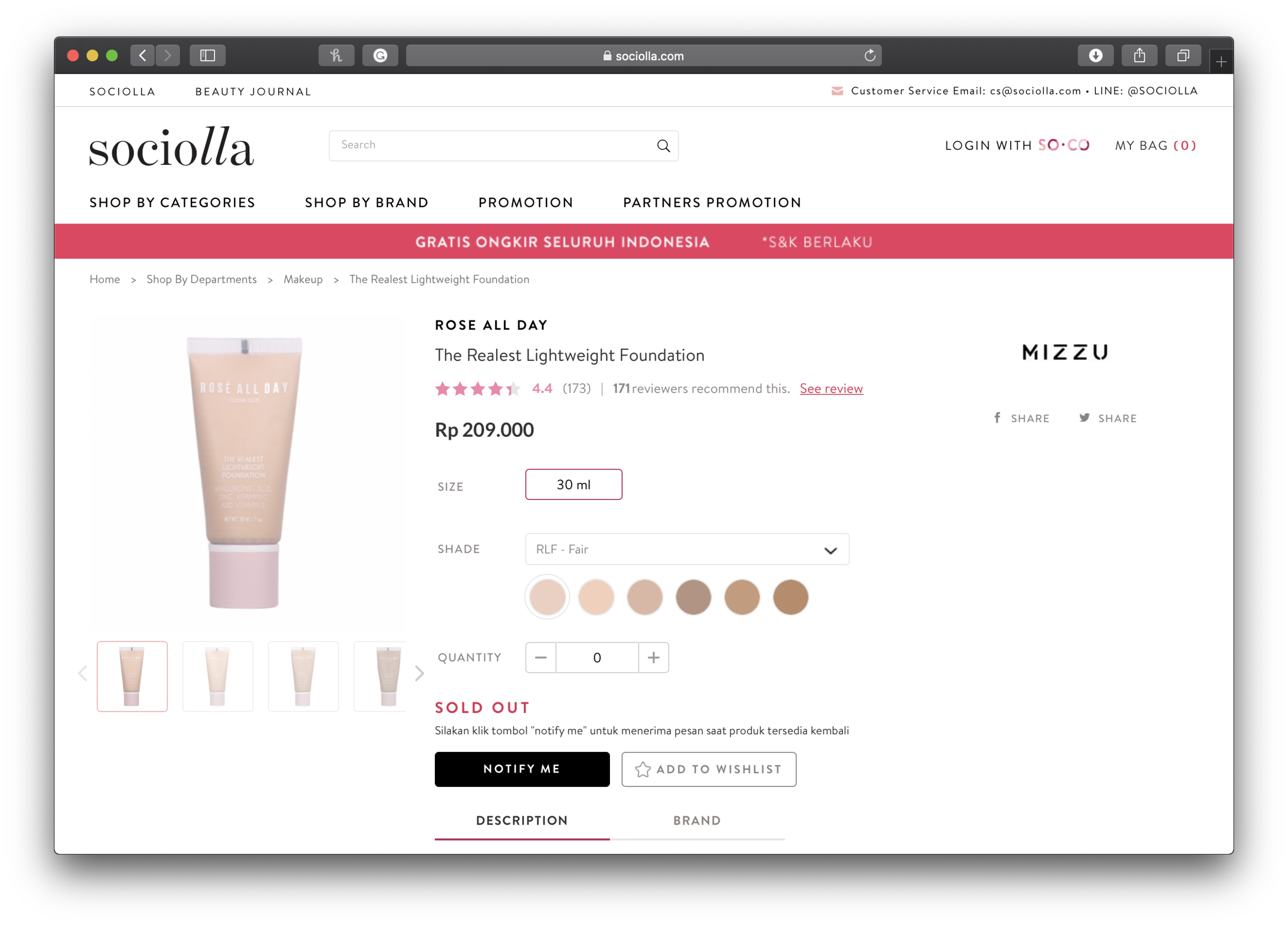Is inclusivity in beauty spread evenly?
Image: Nars store at Senayan City, South Jakarta
They say that having a solid foundation is important, and when it comes to makeup, that famous metaphor is one to be taken literally.
Diversity and inclusivity have been a hot topic in the beauty industry, with global brands putting in efforts to follow suit. Over these past few years, several high-end global brands have expanded their range of foundation shades; MAC’s Studio Fix Fluid foundation now has a total of 63 shades, while Bobbi Brown’s Skin Long-Wear Weightless Foundation has 43 shades.
Western brands have started to make changes in order to be more inclusive, but Indonesian local brands are still lagging behind in this movement. Based on our research on Sociolla, local brands barely reach a range of 10 shades: Mizzu’s Glam Rock Aqua Foundation offers 5 shades, Rosé All Day’s The Realest Lightweight Foundation carries 6 shades and Wardah’s Exclusive Liquid Foundation has 5 shades.
“The majority of Indonesians have a warm undertone, but that doesn’t mean everyone has the same color or shade,” says Liza Adilah, a professional makeup artist. “But sadly, not a lot of local brands consider the diversity of skin tones, and the branding that beauty equals fair is still very much attached to the Indonesian beauty industry.”
Liza, who has been working as a freelance makeup artist for three years, usually ends up buying foundations from pricier international brands in order to have the shades she need for her clients. She has encountered clients who requested to have their makeup done with foundation a few shades lighter than their actual skin tone and those who opposed to using bronzer for fear of looking darker.
Similar situations have happened to model Michelle Tahalea. “I’ve often complained about the foundation that doesn’t match the color of my skin, and the answer I usually receive is that they don’t have the shade for my skin, or didn’t have enough experience doing (makeup) for my skin tone,” she said. “There’s also some that feel like it’s slightly better to tone up my skin, which isn’t.” This has happened so often that she opts to bring her own foundation to shoots just to be safe.
Those are also everyday struggle women face. “I gave up finding the right foundation shade so I quit foundation, concealer and complexion products altogether. Now I only use mascara and blush on,” said Aya, a 30-year old writer.
Emma, a 27-year-old F&B entrepreneur who has a light medium skin tone, also has a hard time finding the right foundation shade. “The foundation either oxidises or too light for my skin. It’s so frustrating!”
Despite inclusivity efforts from global brands, something is amiss in terms of fulfilling demands from the other side of the world. For instance, on the Sephora Indonesia website, Too Faced offers 11 shades of foundation while listing 34 shades on its official website. MAC’s Studio Fix Fluid foundation only has 38 shades available for Sephora, when in reality it has a total of 63 shades.
The data we collect suggests that most shades the retailers carry are light, light medium and medium. Tan to medium dark are limited to a few brands. What’s more interesting is that some brands in Sephora that already have their own stores in Jakarta provide a complete range of shades on their store, but not in Sephora.
Of course, we also take into account Sephora’s store space. There is only so much it can take since the retailer has to accommodate a lot of brands into its store. The shade range on Sephora’s website is roughly the same, while Sociolla has even smaller range.
With clients having their makeup done in foundation shades lighter than their true skin tone, and a higher availability of products for lighter shades compared to that of darker shades, it’s clear that whiter, fairer skin is still favoured. This bias is most likely because inert colorism (prejudicial or preferential treatment of same-race people based solely on their color) is still present in Indonesia’s society.
Awareness of inclusivity and diversity in Indonesia is growing at a slower pace than in Western countries, but small steps are being taken.
Image: Make Over
“There’s already a few brands and figures in the beauty industry that are trying to make diversity the new thing,” Liza said. “Renowned makeup artist Arman Armano, for example, has been posting his makeup works for models with super dark skin.”
Another example is Make Over, a local beauty brand that has expanded the shade range for its Demi Matte cushion to 10 shades this January from only 6 shades last May. The brand also started posting guides on social media to help consumers figure out the right shade for their skin tone. In addition, their campaign features models with a diverse range of skin tones, including Michelle herself.
“Now, almost every brand (especially beauty brands) embraces topics like skin diversity, self-love, etc. in their campaigns, which is good because Indonesia has a lot of different skin tones,” Michelle says, talking about the progress of inclusivity over these past three years, “We still need a lot more diversity in beauty standards, and I hope that this is not just a trend.”




